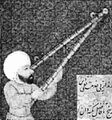Template:Selected anniversaries/December 7: Difference between revisions
Jump to navigation
Jump to search
No edit summary |
No edit summary |
||
| (3 intermediate revisions by the same user not shown) | |||
| Line 15: | Line 15: | ||
||1869: Outlaw Jesse James commits his first confirmed bank robbery in Gallatin, Missouri. | ||1869: Outlaw Jesse James commits his first confirmed bank robbery in Gallatin, Missouri. | ||
||1903: Danilo Blanuša born ... mathematician, physicist, and academic. Pic search: https://www.google.com/search?q=danilo+blanuša&oq=Danilo+Blanuša | ||1903: Danilo Blanuša born ... mathematician, physicist, and academic. Pic search: https://www.google.com/search?q=danilo+blanuša&oq=Danilo+Blanuša | ||
| Line 34: | Line 32: | ||
||1924: Mary Ellen Rudin born ... mathematician known for her work in set-theoretic topology. Pic. | ||1924: Mary Ellen Rudin born ... mathematician known for her work in set-theoretic topology. Pic. | ||
||1933: Mathematician and Jesuit priest James Cullen born. He contributed to what are now called Cullen numbers. No pics online. | |||
||1941: World War II: Attack on Pearl Harbor: The Imperial Japanese Navy carries out a surprise attack on the United States Pacific Fleet and its defending Army and Marine air forces at Pearl Harbor, Hawaii. (For Japan's near-simultaneous attacks on Eastern Hemisphere targets, see December 8.) | ||1941: World War II: Attack on Pearl Harbor: The Imperial Japanese Navy carries out a surprise attack on the United States Pacific Fleet and its defending Army and Marine air forces at Pearl Harbor, Hawaii. (For Japan's near-simultaneous attacks on Eastern Hemisphere targets, see December 8.) | ||
||1943: Henry Louis Rietz dies ... mathematician, actuarial scientist, and statistician, who was a leader in the development of statistical theory. Pic: https://www.maa.org/about-maa/governance/maa-presidents/henry-lewis-rietz-1924-maa-president | ||1943: Henry Louis Rietz dies ... mathematician, actuarial scientist, and statistician, who was a leader in the development of statistical theory. Pic: https://www.maa.org/about-maa/governance/maa-presidents/henry-lewis-rietz-1924-maa-president | ||
||1952: Forest Ray Moulton dies ... astronomer and academic. In the first decades of the twentieth century, some additional small satellites were discovered to be in orbit around Jupiter. Dr. Moulton proposed that these were actually gravitationally-captured planetesimals. This theory has become well-accepted among astronomers. Pic. | ||1952: Forest Ray Moulton dies ... astronomer and academic. In the first decades of the twentieth century, some additional small satellites were discovered to be in orbit around Jupiter. Dr. Moulton proposed that these were actually gravitationally-captured planetesimals. This theory has become well-accepted among astronomers. Pic. | ||
| Line 53: | Line 49: | ||
||1972: Apollo 17, the last Apollo moon mission, is launched. The crew takes the photograph known as The Blue Marble as they leave the Earth. | ||1972: Apollo 17, the last Apollo moon mission, is launched. The crew takes the photograph known as The Blue Marble as they leave the Earth. | ||
||1977: Peter Carl Goldmark dies ... engineer ... instrumental in developing the long-playing microgroove 33-1/3 rpm phonograph disc. Pic. | |||
File:Cecilia Helena Payne-Gaposchkin.jpg|link=Cecilia Payne-Gaposchkin (nonfiction)|1979: Astronomer and astrophysicist [[Cecilia Payne-Gaposchkin (nonfiction)|Cecilia Payne-Gaposchkin]] dies. Her doctoral thesis established that hydrogen is the overwhelming constituent of stars, and accordingly the most abundant element in the universe. | File:Cecilia Helena Payne-Gaposchkin.jpg|link=Cecilia Payne-Gaposchkin (nonfiction)|1979: Astronomer and astrophysicist [[Cecilia Payne-Gaposchkin (nonfiction)|Cecilia Payne-Gaposchkin]] dies. Her doctoral thesis established that hydrogen is the overwhelming constituent of stars, and accordingly the most abundant element in the universe. | ||
| Line 65: | Line 63: | ||
||2009: Ray Solomonoff dies ... inventor of algorithmic probability, his General Theory of Inductive Inference (also known as Universal Inductive Inference), and was a founder of algorithmic information theory. He was an originator of the branch of artificial intelligence based on machine learning, prediction and probability. Pic: https://www.researchgate.net/publication/267090779_Ray_Solomonoff_and_the_New_Probability | ||2009: Ray Solomonoff dies ... inventor of algorithmic probability, his General Theory of Inductive Inference (also known as Universal Inductive Inference), and was a founder of algorithmic information theory. He was an originator of the branch of artificial intelligence based on machine learning, prediction and probability. Pic: https://www.researchgate.net/publication/267090779_Ray_Solomonoff_and_the_New_Probability | ||
||2010: John E. Baldwin dies ... contributed to the development of interferometry in Radio Astronomy, and later astronomical optical interferometry and lucky imaging; and made the first maps of the radio emission from the Andromeda Galaxy. Pic. | |||
||2015: The JAXA probe Akatsuki successfully enters orbit around Venus five years after the first attempt. | ||2015: The JAXA probe Akatsuki successfully enters orbit around Venus five years after the first attempt. | ||
</gallery> | </gallery> | ||
Latest revision as of 17:05, 7 February 2022
903: Astronomer Abd al-Rahman al-Sufi born. He will publish his Book of Fixed Stars in 964.
1823: Mathematician Leopold Kronecker born. His work will include number theory, algebra, and logic.
1963: Instant replay makes its debut during the Army-Navy football game in Philadelphia, Pennsylvania, United States.
1979: Astronomer and astrophysicist Cecilia Payne-Gaposchkin dies. Her doctoral thesis established that hydrogen is the overwhelming constituent of stars, and accordingly the most abundant element in the universe.



